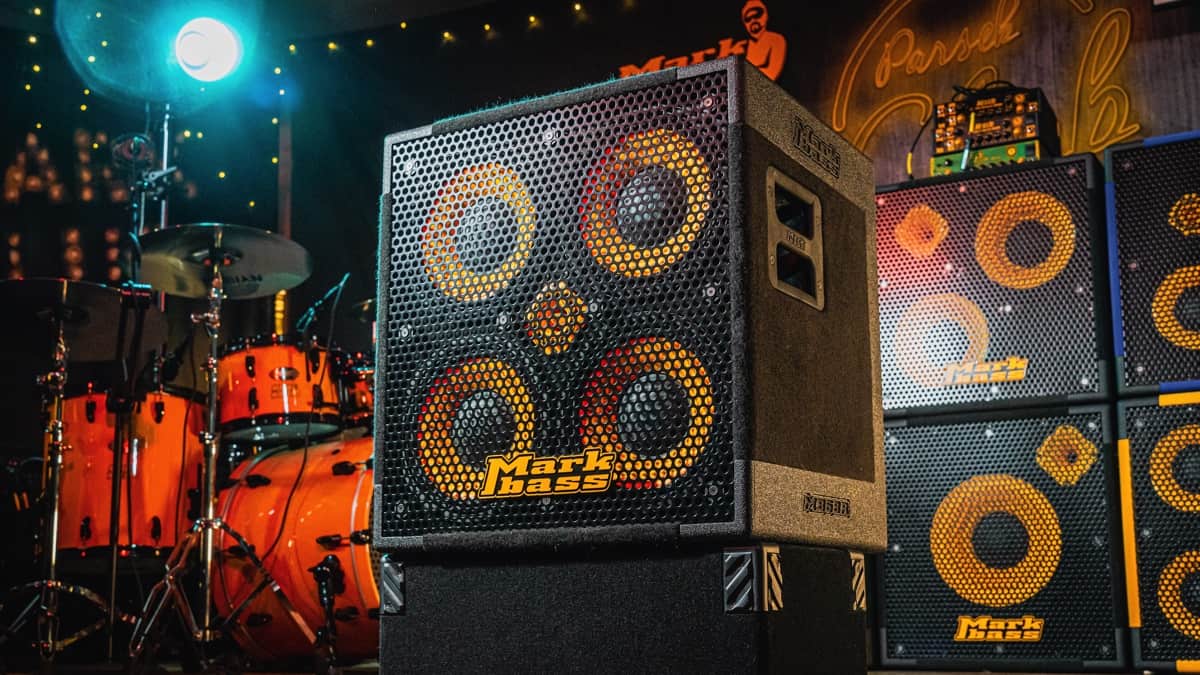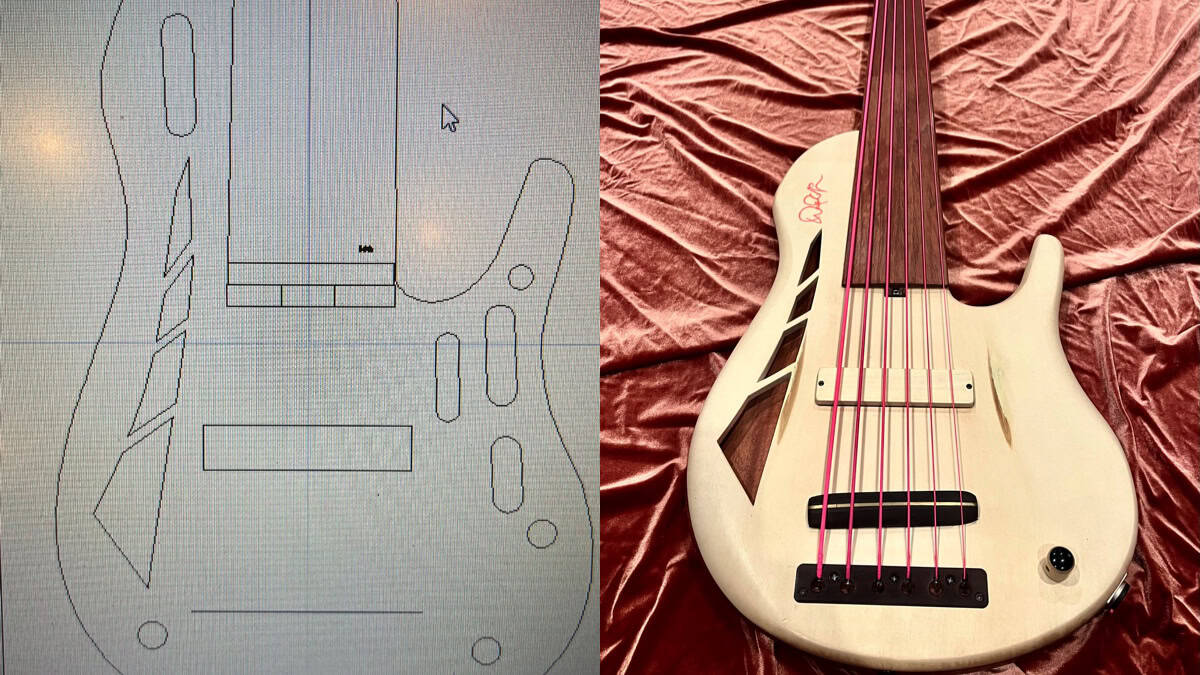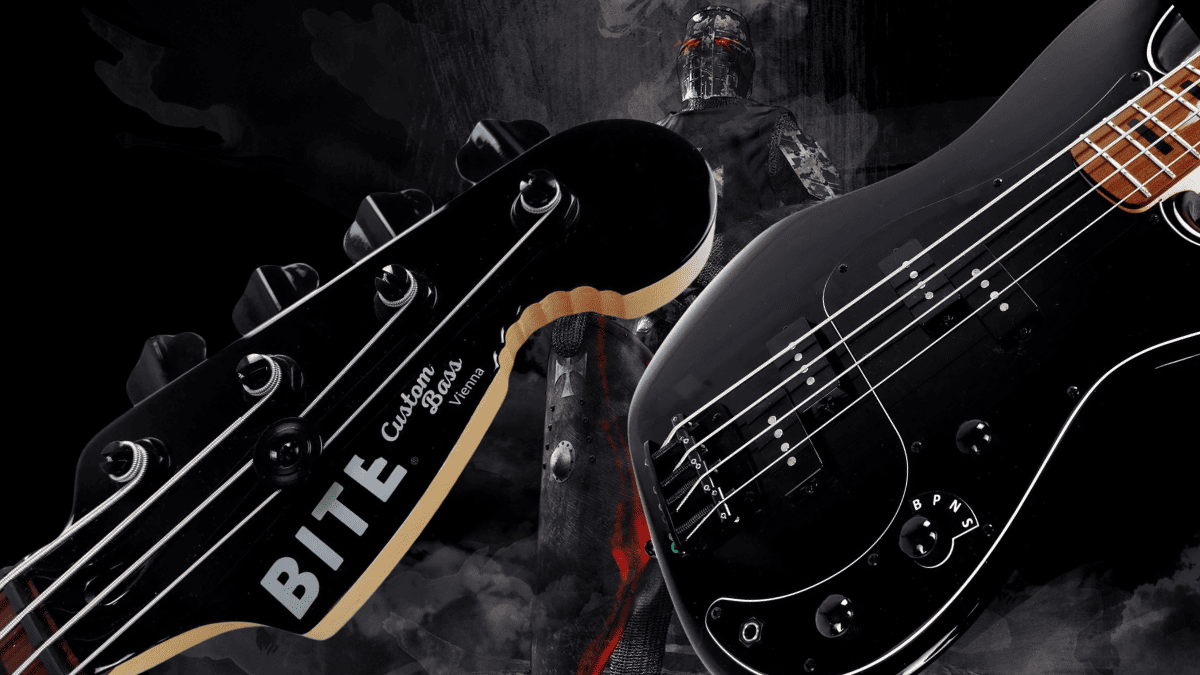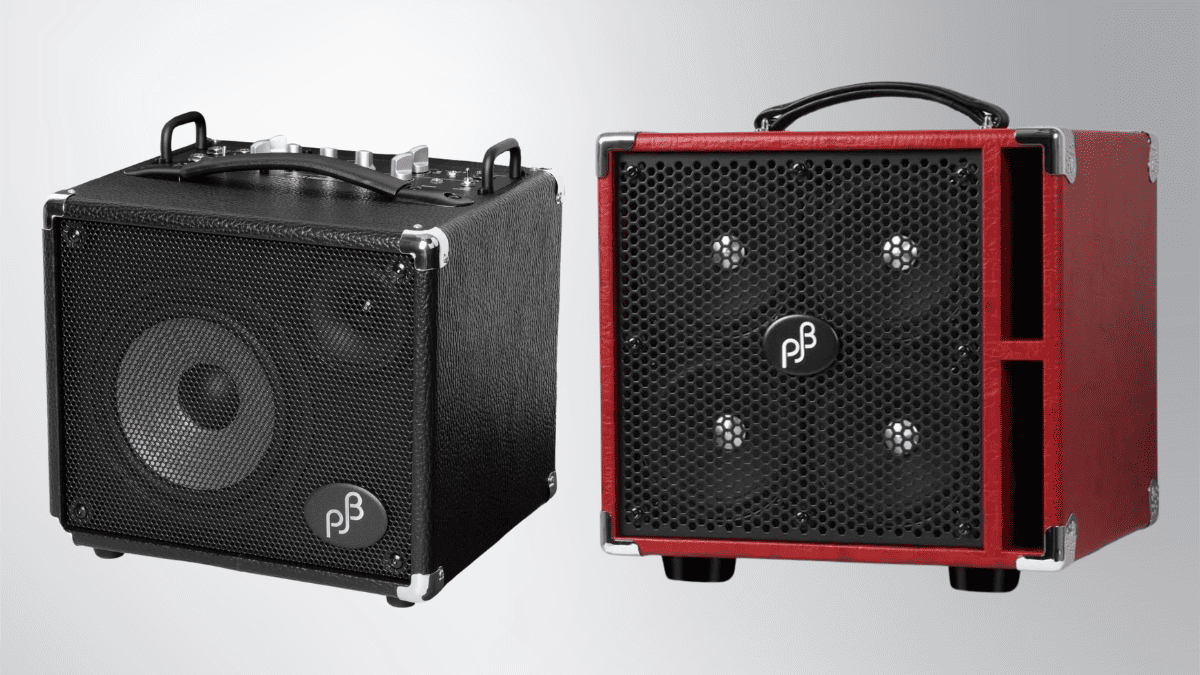Gear Reviews
Reviews: Markbass Little Mark 58R and MB58R 104 PURE

Markbass Little Mark 58R and MB58R 104 PURE…
Markbass’s commanding presence in the bass amp market has been steadily growing since Marco De Virgiliis founded the company in 2001 with an aptitude for relentless innovation. The company was on the leading edge of the neodymium driver and class D amplifier revolution and has been pushing the boundaries of size, weight, and portability. I remember well when the Little Mark II hit, making a huge splash in the market and becoming a benchmark for lightweight, high-power, great-sounding bass heads. Decades later, they have become omnipresent in clubs and venues as the brand of choice for many working players and backlines. The brand’s availability and popularity mean that for most of us, somewhere, sometime, we’ve played a Markbass rig or heard one on stage. But to be honest, the thing I think of when it comes to Markbass is how versatile the brand has become. I don’t know of another bass amp company that manages to keep happy such a wide stylistic variety of players. Slap kings Andrew Gouche, Mark King, and Marcus Miller? Check. Fingerstyle virtuosos Hadrien Feraud, Richard Bona, and Evan Marien? Yup. Alain Caron, Michael League, Joe Dart, Tom Kennedy? Yessir. There really, honestly, truly seems to be something in their line designed for just about every playing style and tone preference.
In keeping with that relentless innovation and anticipation of their customer’s desires, new from Markbass is their MB58R line, including a wide range of almost incomprehensibly lightweight 10”, 12” and 15” based cabinets, and their Little Mark 58R head. The MB58R line of cabinets includes the “PURE” series, with Markbass neodymium custom speakers and a special new hi-fi tweeter (very focused with sweet and rounds highs), the “ENERGY” Series, with Markbass neodymium custom speakers and 1” driver with horn (warm low mids that sweeps evenly into a punchy, clear, honest, accurate sound) and the “P” Series, (Markbass ceramic custom speakers and a new piezo tweeter, for classic sound in a lightweight package).
Markbass sent over their new Italian-made Little Mark 58R head and MB58R 104 PURE cab for testing and, I have to say, as someone who has been away from Markbass gear for some time, their new offerings showcase the evolution and development they’ve been working hard at for many years.
Little Mark 58R

The Little Mark 58R is reminiscent of my old beloved Little Mark II/III amps, but with some obvious changes and refinements in design. Most notably, all of the in/out jacks (aside from the speaker output) reside on the front panel. A 3-way rotary-switch allows a Flat, Scooped or FSW (Footswitchable) EQ options, and a variable “Old School” control rolls off the highs and thickens the mids, kind of like their classic “VLE” (vintage loudspeaker emulator) knob. The well-voiced 4-band equalizer is present, as well as a mute switch (which when in mute mode, causes the transparent casing for the ¼” input jack to flash on and off as handy status indicator).
Since the front panel features almost all of the i/o jacks, the spartan rear panel only contains the IEC power socket, a single Speakon output and two ¼” speaker outputs.
MB58R 104 PURE

Lifting the 35 lb. 4×10 out of its shipping carton, I had to double-check that they remembered to put the drivers in it. The lightweight neo drivers and composite enclosure honestly feel like you’re lifting an empty cardboard box. Markbass really nailed the portability goals for what feels like an impossibly light 4×10 cab. The rear porting of the cabinet allowed for a smaller front panel footprint and a diminutive cube-like stature, since there is no need for additional real estate for porting, and between the size and weight, the 104 feels easier to schlep than some of the neo 310’s I’ve maneuvered. 3 switches on the rear of the cab offer several different tweeter settings (-15dB, -9dB, -6dB, 0dB) for the cab’s hi-fi tweeter.
In testing, the Markbass “58R” rig delivered big, full-blooded sound, that didn’t sound nearly as light as the gear itself. This setup is capable of achieving a range of tones from big aggressive slap tones, textured midrange “P bass heaven” sounds and everything in between. For a 500w-rated head, the Little Mark 58R and 104 are super loud and punchy with great headroom. The 3-position tone control knob and “old school” control offer more than enough global tone shaping, and with some additional fine-tuning via the 4-band EQ, I was easily able to find a number of great sounds to fit my instruments and the band mix. And of course, when it comes time to move it, it’s a dream come true. I was super impressed with the rig’s “power to weight ratio” and would happily drag this out in settings where I would normally begrudge myself to drag a 4×10 around. Oops, Markbass did it again.
The MB58R 104 PURE retails for $949.99 and the Little Mark 58R $599.00. For more information, visit Markbass online at markbass.it
Gear
New Joe Dart Bass From Sterling By Music Man

Sterling by Music Man introduces the Joe Dart Artist Series Bass (“Joe Dart”), named after and designed in collaboration with the celebrated Vulfpeck bassist.
Above photo credit: JORDAN THIBEAUX
This highly-anticipated model marks the debut of the Dart bass in the Sterling by Music Man lineup, paying homage to the Ernie Ball Music Man original that all funk players know and love. The bass embodies many of the original model’s distinctive features, from its iconic minimalist design to the passive electronics.

The design process prioritized reliability, playability, and accessibility at the forefront. Constructed from the timeless Sterling body, the Dart features a slightly smaller neck profile, offering a clean tone within a comfortable package. The body is crafted from soft maple wood for clarity and warmth while the natural finish emphasizes the simple yet unique look.
Engineered for straightforward performance, this passive bass features a ceramic humbucking bridge pickup and a single ‘toaster’ knob for volume control. Reliable with a classic tone, it’s perfect for playing in the pocket. The Dart is strung with the all-new Ernie Ball Stainless Steel Flatwound Electric Bass Strings for the smoothest feel and a mellow sound.

The Sterling by Music Man Joe Dart Bass is a special “Timed Edition” release, exclusively available for order on the Sterling by Music Man website for just one month. Each bass is made to order, with the window closing on May 31st and shipping starting in November. A dedicated countdown timer will indicate the remaining time for purchase on the product page. Additionally, the back of the headstock will be marked with a “2024 Crop” stamp to commemorate the harvest year for this special, one-of-a-kind release.
The Joe Dart Bass is priced at $399.99 (MAP) and can be ordered globally at https://sterlingbymusicman.com/products/joe-dart.
To learn more about Joe Dart, visit the official Vulfpeck artist site here https://www.vulfpeck.com/.
Gear Reviews
The Frank Brocklehurst 6-String Fretless Bass Build

A few months ago, my Ken Bebensee 6-string fretted bass needed some TLC. You know, the one rocking those Pink Neon strings! I scoured my Connecticut neighborhood for a top-notch luthier and got pointed to Frank Brocklehurst, F Brock Music. He swung by my place, scooped up the bass, and boom, returned it the next day, good as new. Not only that, he showed up with a custom 5-string fretted bass that blew me away. I couldn’t resist asking if he could whip up a 6-string fretless for me.
Alright, let’s break down the process here. We’ve got our raw materials: Mahogany, Maple, and Holly. Fun fact – the Mahogany and Maple have been chilling in the wood vault for a solid 13 years. Frank is serious about his wood; they buy it, stash it away, and keep an eye on it to make sure it’s stable.
First up, they’re tackling the Mahogany. Frank glues it together, then lets it sit for a few days to let everything settle and the glue to fully dry. After that, it’s onto the thickness planer and sander to get it nice and flat for the CNC machine. The CNC machine’s the real star here – it’s gonna carve out the body chambers and volume control cavity like a pro.
While the Mahogany’s doing its thing, Frank goes onto the neck core. Three pieces of quartersawn maple are coming together for this bad boy. Quartersawn means the grain’s going vertical. He is also sneaking in some graphite rods under the fingerboard for stability and to avoid any dead spots. The truss rod is going to be two-way adjustable, and the CNC machine’s doing its magic to make sure everything’s just right.
Now, onto the design phase. Frank uses CAD software to plan out the body shape, neck pocket, chambering, and those cool f-holes. I had this idea for trapezoid F-holes, just to do something different. The CAD software also helps us map out the neck shape, graphite channels, and truss-rod channel with pinpoint accuracy.

Once everything’s planned out, it’s CNC time again. Frank cuts out the body outline, neck pocket, and the trapezoid F-holes. Then it’s a mix of hand sanding and power tools to get that neck just how we like it. Oh, and those f holes? We’re going for trapezoids of different sizes – gotta keep things interesting.
Next step: gluing that neck into the pocket with some old-school hide glue. It’s got great tonal transfer and can be taken apart later if needed. Then it’s onto hand-carving that neck-body transition.
For the custom-made bridge, Frank uses brass for definition and Ebony for tonal transfer and that warm, woody sound.
BTW, for tunes, Frank went with Hipshot Ultralights with a D Tuner on the low B. This way I can drop to a low A which is a wonderful tone particularly if you are doing any demolition around your house!
Now it’s time for the side dots. Typically, on most basses, these dots sit right in the middle of the frets. But with this bass, they’re placed around the 1st, 3rd, 5th, 7th, 9th, and 12th frets.
Frank’s got his pickup hookup. Since the pickup he was building wasn’t ready, he popped in a Nordstrand blade to give it a whirl.
It sounded good, but I was itching for that single-coil vibe! And speaking of pickups, Frank showed me the Holly cover he was cutting to match, along with all the pink wire – talk about attention to detail!
A couple of things, while it is important for me to go passive, it is equally important for me to just go with a volume knob. Tone knobs are really just low-pass filters and the less in the way of a pure sound for me, the better.
Finally, it’s string time! As usual, I went for the DR Pink Neon strings. Hey, I even have matching pink Cons…Both low tops and high!
Once we’ve got everything tuned up and settled, we’ll give it a day or two and then tweak that truss rod as needed. And voila, we’ve got ourselves a custom-made bass ready to rock and roll.
I want to thank Frank Brocklehurst for creating this 6 string beast for me.
Gear Reviews
Review Transcript: BITE Custom Bass – The Black Knight PP Bass

This is a written transcript of our video review of the BITE Custom Bass Black Knight PP Bass originally published on March 4, 2024
BITE Custom Bass – The Black Knight PP Bass Review…
Bass Musician Magazine did a review on a Steampunk bass from BITE Guitars about three years ago, it was an amazing instrument, and we were very impressed. Now we’re happy to bring you another BITE bass, the Black Knight PP.
Everybody needs a P-type bass, it’s the standard of bass. If you’re recording, they want you to have a P bass. So why not have something that gives you a little more by having two instead of one P pickup. That’s the idea of this bass, it’s the first thing that leaps out: the double P pickup configuration.
Installing two of their 1000 millivolt split-coil pickups, BITE then went one step further and wired them up in a 4-way parallel/series circuit, a look at the controls reveal a 4-way rotary selector:
The first position, marked “B”, gives you the bridge pickup by itself.
The second position, marked “P”, gives you the bridge and neck pickups in parallel mode, that’s the traditional J-type circuit, it reduces output due to the physical law of parallel circuits.
Position number 3 is marked “N”, it gives you the neck pickup by itself.
And finally, number 4, marked “S”, gives your bridge and neck in a series (humbucking) mode which adds up resistances and thus boosts output. The other two controls are master volume and master tone.
What’s more, like every BITE bass, this one also has a reinforced headstock heel designed to give it extra output and sustain. The BITE website features a graph and explanation of what they have done to the heel, as compared to traditional headstocks.
A look at the body reveals a beautiful Black Blast body finish and underneath that we have alder wood. The bass has a matching headstock with a 4-in-line tuner setup and the traditional bite out of it, so everybody will know what kind of bass you’re playing. The pickguard is 3-ply black, the neck is vintage tinted hard maple and it has a satin speed finish at the back which keeps your thumb from sticking.
On top of that, there’s a clear-coated roasted black locust fretboard with black blocks marking the frets. The nut is a black Graph Tec nut, we’ve got diamond dome control knobs, and the tuners are lightweight compacts with cloverleaf buttons and a 1:17 ratio precision gear. The bridge is a Gotoh brass bridge with 19-millimeter string spacing.
Overall measurements: we’ve got a standard 34″ scale, a 1.65″ width nut and a C neck profile. This bass weighs 8.2 pounds, or 3,7 kilograms for our metric friends, and it uses standard 18% nickel silver frets.
Taking a closer look at the sound, this bass is a joy to play. The BITE proprietary 1000 millivolt pickups deliver an extraordinary amount of output which is surprising considering this is a passive instrument. You may even want to set your amp to active mode because of all of the juice you’re getting out of this guy.
The tonal possibilities are very versatile, it’s a straight P if you want but also much more with those different arrangements of the circuitry. So why have multiple basses when you’ve got one that can give you your basic P plus a lot more?
To sum it up, the Black Knight PP is an amazing instrument. The attention to detail that BITE puts into their basses is second to none. This bass is also amazingly balanced and gorgeous to hold and feel with the satin neck finish.
For more information, visit online at bite.guitars/product/black-knight-pp
Bass Videos
Reviews: Phil Jones Bass Compact Plus 450 and Bass Engine 17

Phil Jones Bass Compact Plus 450 and Bass Engine 17 Reviews…
In this issue, we take an in-depth look at two new amps from Phil Jones Bass, the Compact Plus 450 and Bass Engine 17.
For more information, visit online at pjbworld.com
Bass Videos
Video Review: BITE Custom Bass – The Black Knight PP Bass

BITE Custom Bass – The Black Knight PP Bass Review…
I am sure many of you saw my review of the Snobby Steampunk Bass from BITE Guitars back in February of 2021 and will remember what a remarkable bass it was. BITE has been building custom basses since 2019 and has a unique custom approach where you can configure your bass to your specs.
I am very excited to have another Bass From BITE Guitars in my hands, The Black Knight PP Bass!
The need for a P-Bass in one’s armamentarium is pretty standard for bass players and I recall chatting about this with Marty O’Brien about a year ago. It turns out that Marty and BITE Guitars got together and came up with this excellent configuration that gives you a P-Bass with a whole lot more. Marty even played his own Black Knight PP bass at the 2024 NAMM show. You can see his review here.
Join me as I take an in-depth look at this very cool instrument and share all the details.
Here is The Black Knight Bass from BITE Guitars!
For more information, visit online at bite.guitars/product/black-knight-pp




























